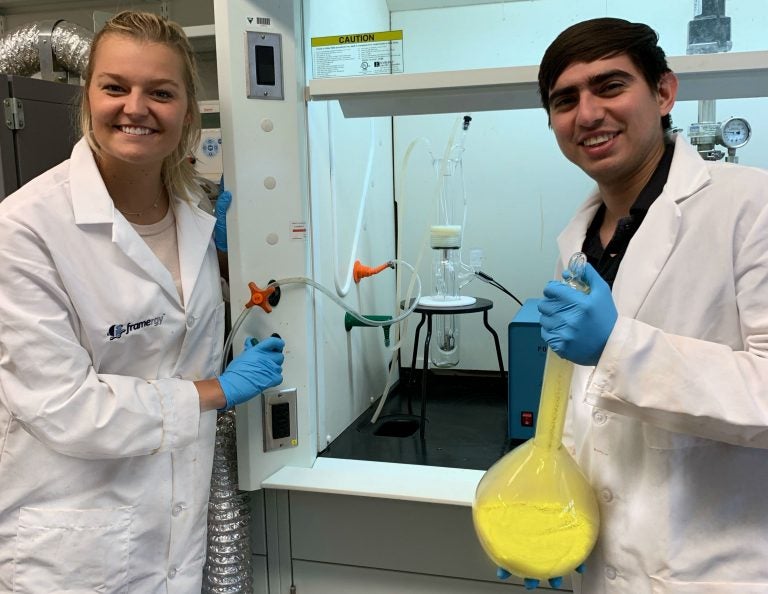‘Radical idea’ from Del. company could help mitigate PFAS contamination
A company incorporated in Delaware won $100,000 EPA grant for technology that could help remove PFAS contamination that’s been found near military bases.
Listen 0:55
Framergy’s MOFs technology have a big impact on cleaning up PFAS contamination. (Courtesy of Framergy)
Like many companies incorporated in Delaware, Framergy doesn’t have offices or employees located within the state’s borders. But the technology they’re developing could have a big impact on cleaning up a group of chemicals that are becoming a big concern in Delaware and lots of other places.
In July, tests at Dover Air Force Base showed four wells east of the base had PFAS levels higher than the EPA’s standard of 70 parts per trillion. Sometimes called “forever chemicals,” these manmade perfluoroalkyl and polyfluoroalkyl chemicals don’t break down in the environment and can accumulate over time.
The newly-discovered contamination comes after a contaminated well was found near the base in 2016.
The EPA is funding Framergy’s research into a way to remove PFAS contamination. The company was founded in 2011 out of Texas A&M University. Its technology focuses on something called metal-organic frameworks, or MOFs. The MOFs have an incredible surface area — a MOF the size of a penny could be unwrapped to cover an entire football field.
“That‘s useful because it allows us to tune the materials to be molecularly specific to pick out one molecule over another,” said Jason Ornstein, Framergy president. Because they can be tuned to catch specific chemicals, MOFs are able to target and capture PFAS in the environment, he said.
At the outset, the company was working to develop a natural gas alternative for vehicles. But while doing that work, researchers were also exploring other applications for MOFs. “We sometimes played around with kind of radical ideas to solve new problems, and the PFAS solution that we’re talking about today is a result of that,” Ornstein said. He describes the materials as “extremely advanced versions of what you might find in a water filter, the black carbons that you see.”
But Ornstein said Framergy’s MOFs go beyond just capturing PFAS. “What we proposed was not only the capture but also the improvement of the materials so that you wouldn’t have to dispose of them,” he said. The MOFs use UV light to actually break down the PFAS chemicals. “Hopefully you’re using just natural sunlight — UV rays — to catalyze and break it down into less harmful components,” Ornstein said.
Last month, the EPA awarded Framergy a $100,000 grant through the Small Business Innovation Research program. The company is currently working on understanding how wastewater is collected and deposited in the soil so they can develop an engineering solution to apply their chemistry to actually doing the work of removing PFAS chemicals. They’re testing the technology at the Firefighter Recruit Academy in College Station, Texas.
“The SBIR will be part of the process of taking the known chemistry and then building an engineering platform around that in which to go into an Air Force base or go into a firefighter training facility and clean it up,” Ornstein said.
PFAS contamination has been found near multiple facilities due to the use of firefighting foam that contained the chemicals.
Framergy will apply for another phase of the grant worth $300,000 next year. It’s not clear when their technology will be ready to hit the market, but Ornstein expects rapid implementation once it does. “The ability to develop this with corporate partners will probably move faster than anything we’ve dealt with before,” he said. “I think the attention that the EPA has focused on this, again in partnership with other agencies, is alarm-bell ringing.”
The EPA says PFAS can cause reproductive and developmental, liver and kidney effects, and problems with the immune system in laboratory animals.
WHYY is your source for fact-based, in-depth journalism and information. As a nonprofit organization, we rely on financial support from readers like you. Please give today.





